|
Sleeping Beauties of the Far East
Japan’s Ryokan, South Korea’s Hanok, and
Mongolia’s Ger
Traditional Guesthouses and Inns
Offer More Authentic Views of Respective Cultures
Article and photos by
Lies Ouwerkerk
Senior
Contributing Editor
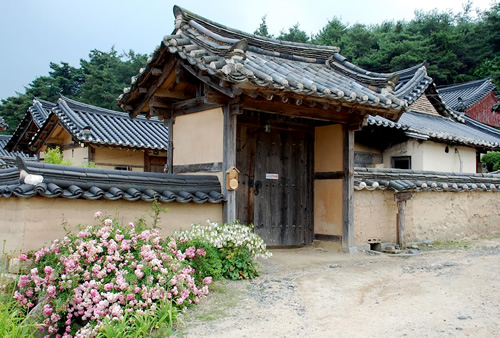
|
|
Hanoks
in Hahoe village, South Korea.
|
|
Staying at traditional guesthouses where
architecture and atmosphere of days long gone have been
preserved, can be a unique cultural experience when you
travel abroad. Recently exploring several countries in the
Far East, I had a peek into ancient rituals and ways of
life in old-fashioned Japanese inns, traditional Korean
houses, and Mongolian nomad tents.
Ryokan in Japan
The earliest ryokan, Japanese-style
inns, date back to the Edo era,
when fatigued travelers along the busy road between Tokyo
and Kyoto needed a place to eat and spend the night. In
today’s Japan, ryokan exist in all parts of the
country, varying in styles, amenities, and prices. They
all have these characteristics in common: a small entrance
area where you take off your shoes and put on slippers;
rice paper-paneled sliding doors opening into the actual
guestroom; tatami (reed) mats on the floor; sleeping
quilts, and futons that are laid out after dinner in your
room; and a yukata, a cotton robe, to wear in the
guestroom or walk to the onsen, the common bath
inside or outside the guesthouse.
Bathing in an onsen — a
distinct feature of Japanese culture — is usually done
before dinner is served. Although traditionally men and
women bathed together, single-sex bathing is nowadays the
norm. According to onsen etiquette, you take off
your clothes and put them temporarily in a basket or locker
in the bathing area. Then you wash and rinse yourself thoroughly
outside the bath to ensure cleanliness, as the baths are
only destined for soaking and relaxing. Although most onsen are
considered public baths, I visited several ryokan where
private time could be reserved by the hour. No bathing suits
or towels are worn in the baths. The temperature of the
water can be very high, so be careful not to stay in too
long! Often the water originates from hot springs, especially
at ryokan in the countryside.
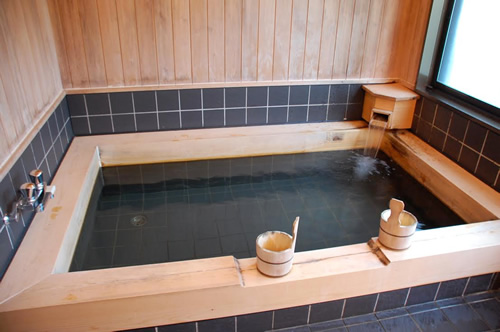
|
|
A typical Onsen in
Japan.
|
|
Once back to my room, dressed in the yukata of
the house and seated on floor cushions or in a chair without
legs at a low table, a hostess in kimono would usually serve
a kaisaki, a traditional multi-course meal, beautifully
displayed and decorated with leaves and flowers. Dinners
in ryokan need to be booked in advance, as they
are very elaborate and always freshly served. They often
include sake with a plate of appetizers, miso soup,
a main meal with fish and meat, pickles, sauce, steamed
vegetables, and ingeniously cut fruits as dessert.
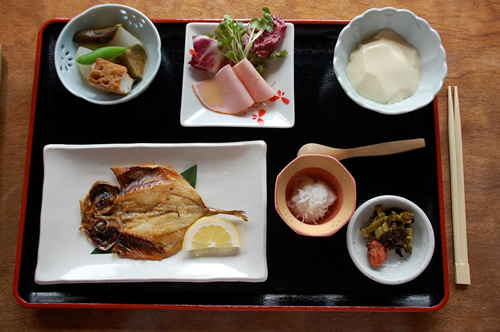
|
|
Japanese
breakfast.
|
|
After the hostess would have cleared
the dishes, she would push the table aside, lay out a futon
mattress on the floor, and make my bed. On some futons I
slept like a baby, others were a bit too hard for comfort
and could keep me awake during the night.
The next morning, the routine would
be repeated in reverse: the mats were rolled up again, the
table put in place, and a meal served. Fish was often the
mainstay of my breakfasts in traditional ryokan.
Hanok in South Korea
Hanoks were traditionally not inns,
but Korean residential homes made of natural materials and
featuring curvy tiled or thatched roofs, ondol (underfloor)
heating, and wooden screen doors with paper panels. They
often face south for maximum sunlight, ideally with the
mountain at their back and a river in front. Also in hanoks
you sleep on futons on the floor.
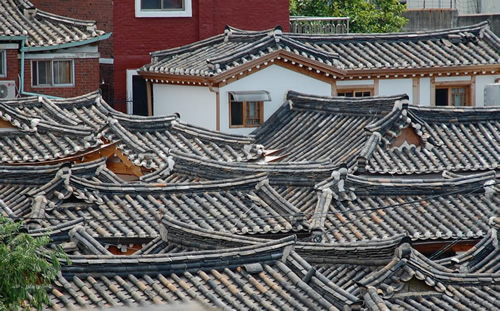
|
|
Roofs of
Hanoks in Seoul.
|
|
Not too many traditional hanoks in South
Korea have survived, partly because they became outdated
and had to make place for more modern developments, partly
because they were mainly made of wood and clay, materials
that were not conducive to long-term preservation. Those
hanoks that did survive the Korean War and post-war redevelopment,
are restored with the help of the Korean government, and
now feature modern amenities and Western-style toilets.
Since living in hanoks came into fashion again, new ones
are built as well.
Clusters of old hanoks can still be
found in Seoul (Bukchon area), Jeonju, and Hahoe. Some of
them have been transformed into guesthouses for travelers
eager to familiarize themselves with Korea’s history and
customs.
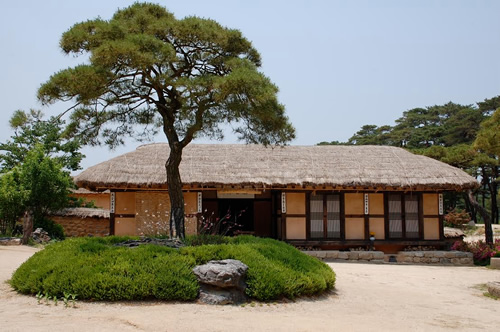
|
|
Hanok (traditional
guesthouse) in Hahoe village, South Korea.
|
|
In de hanoks of Hahoe village, close
to the city of Andong, members of the famous Ryu family
have lived for centuries along the Nakdong River, which
meanders in a large S-shape through the hills of the nearby
mountain Hwa.
Unique characteristics of these beautifully
renovated hanoks are that the houses face the river in different
directions rather than only south, and that the straw-roofed
houses (for peasants) are placed in a circular form around
the tile-roofed ones (for the nobility). On the covered
porch of my hanok guesthouse Rak-Ko-Jae, Korean
or Western breakfast was served in the morning, and bibimbap,
a typical Korean dinner with rice, vegetables, meat and
egg, at night.
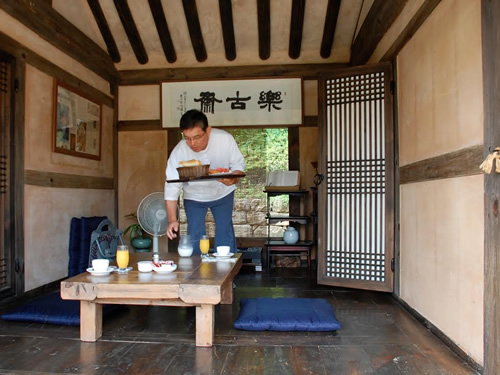
|
|
Breakfast
on a porch of a Hanok.
|
|
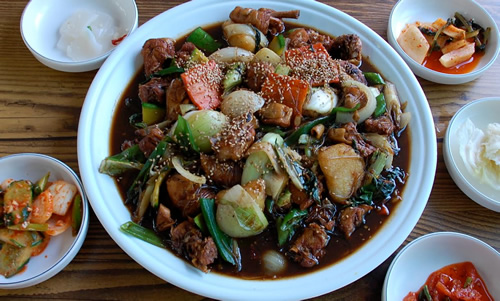
|
|
Bibimbap,
a typical Korean dinner.
|
|
Another notable feature of Hahoe village
is the Mask Dance Museum, displaying masks from Korea and
beyond. In the summer time, there is also an open-air Mask
Dance Theatre with regular performances of Korea’s most
traditional folk plays presented by the villagers themselves.
For generations, satirized dramas between allegorical characters
representing the various social classes used to relieve
tensions among the village families. Although a tad touristy,
all is set in superb scenery, which also lends itself well
to lovely walks in Hahoe and surroundings.
Ger in Mongolia
A Mongolian ger (yurt in
other countries) is a cylindrical tent made of boards, poles,
and wool felt. It can be put up and taken down quickly,
which is important for nomads who move around often in search
of green pastures for their livestock. There is only one
small door, which faces south — away from the cold Northern
wind — and there are no windows. In the middle of the
cone-shaped space is a stove, and its chimney ends in a
small opening at the top of the tent. Beds, cooking utensils,
a few trunks for clothing and other belongings, and a couple
of floor cushions are placed along the sides.
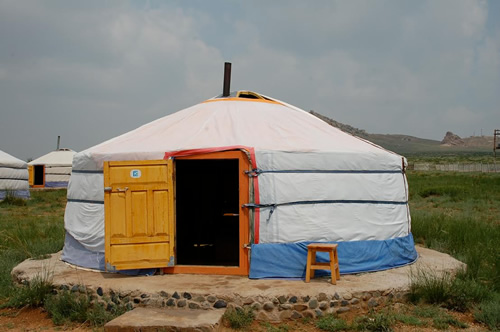
|
|
Outside
of Mongolian Ger.
|
|
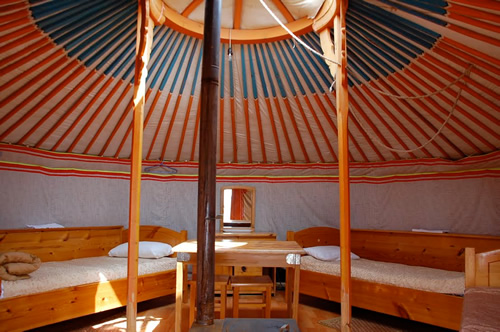
|
|
Inside
a Mongolian Ger.
|
|
Although Mongolian gers are obviously
not ancient structures like Japanese ryokan and
Korean hanoks, they are traditional in the sense that ancestors
of today’s nomads spent their lives in exactly similar circumstances
over past centuries, dating back to the times of the great
Genghis Khan.
During summer time, clusters of gers
are set up for tourists all over the country. Often there
is some kind of tourist attraction nearby, such as sand
dunes, hot springs, Buddhist monasteries, or a national
park.
While staying in a ger in Hustai
National Park, not too far from the capital Ulaanbaatar,
I watched a group of wild horses coming out at sunset to
drink at the river. And to add some traditional flavor,
a band with horse head fiddle instruments performed in the
camp at night.
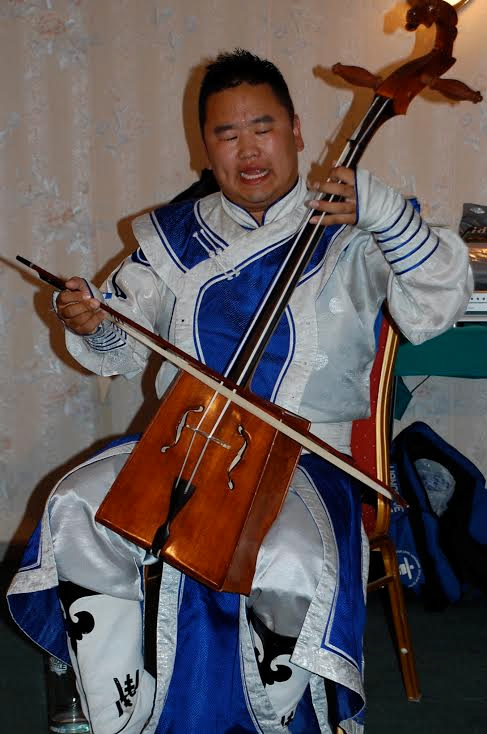
|
|
Horse head
fiddle band "Domog," performing in ger camp
|
|
Although staying in a tourist ger camp
can certainly be a pleasant experience, the closest you
get to the traditional life style of the Mongolian nomads
is, of course, visiting them in their own habitat. My most
memorable moments in Mongolia have been those spent in authentic,
colorfully decorated gers where we were welcomed with a
smile and a traditional sniff bottle; where hosts offered
us airag, salted tea, and local meals; where they
proudly paraded in their traditional outfits, gave moving
throat singing performances, and showed us how to shear
a sheep; and where we were told fascinating stories about
eagle hunting, wrestling matches, and surviving the long
and cold Mongolian winters. For me, that was the authentic
traditional experience. I hope to come back to experience
it again one day soon.
Lies
Ouwerkerk is originally from Amsterdam,
The Netherlands, and currently lives in Montreal,
Canada. Previously a columnist for The Sherbrooke
Record, she is presently a freelance writer and
photographer for various travel magazines.
|
